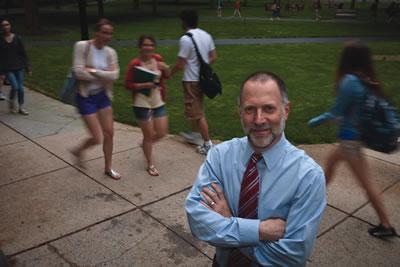Conflict Resolution at Dickinson Beyond the Classroom
Conflict Resolution at Dickinson Beyond the Classroom
The Last Word

With a Ph.D. in folklore and folklife, my work has taken me from being Pennsylvania’s state folklorist to leading a state agency dedicated to ethnic, racial and religious diversity to founding a nonprofit organization that leverages cultural diversity for individual and community development. I have learned that while “difference” and “conflict” often carry negative associations, they actually have the potential to create opportunity, as long as the parties to the difference/conflict do not get side-tracked by the immediate sense of division.
I also have experience as a conflict-management skills trainer, facilitator of community-based conflict resolution and mediator of workplace and interpersonal conflict. Of all of my professional experiences, my work in conflict resolution has been consistently the most personally challenging and rewarding—challenging in finding a place of calm, alertness and creativity in the midst of the messes that people throw at one another, and rewarding in seeing the transformed relationships that can result from effective conflict resolution.
Campus and residential-life staff have long been on the front lines of constructive conflict-resolution efforts. When we think about the total Dickinson experience, we can recognize the “teachable moment” in the mundane conflict incidents that grow out of living together, participating in clubs and organizations, playing on teams and working together on class projects. Through ongoing staff development, we created a network of student and professional residential-life staff to help students recognize the early stressors and to see that they have choices that can lead to constructive conflict management, if not actual resolution.
Of course, students are not the only ones to experience conflict at Dickinson. Employees experience it as well, at every level of the organization. I remember discussing workplace mediation with members of the Faculty Personnel Committee, and I distinctly recall the colleague who assured me that faculty members do not have conflicts with one another! Of course, that’s not true, and I’ve been pleased to be able to play a role in working with individual professors and even departments. By actively resolving conflict, faculty members have been able to turn their attention back to their teaching and research.
For years, I’ve offered conflict-management skills workshops to employees, including a 40-hour workplace mediator training program for staff and administrators. In recent years, Human Resources Services has embraced conflict coaching (where one works with an individual party in a conflict situation) and conflict mediation. The goal here is to provide employees the tools for problem solving and constructive conflict resolution before interpersonal conflict escalates to affect job performance or leads to personnel action.
I also have the opportunity to teach conflict resolution as an academic subject. In alternate years, I offer Conflict and Conflict Resolution Studies as an introduction to the field, and Religion: Conflict, Violence and Peacemaking. Both courses routinely fill to their maximum and count toward the security-studies certificate program. Students have gone on to M.A. and Ph.D. work in peace and conflict studies, as well as work in nonprofits domestically and NGOs internationally. Several were awarded grants from the Davis 100 Projects for Peace program and designed and implemented peace-building projects in Brazil, Nepal, Northern Ireland and Washington, D.C.
Shalom D. Staub is associate provost for academic affairs and first-year class dean.
Published July 1, 2012